Intel Core Duo USB Issue: A Mischaracterized Bug
by Anand Lal Shimpi on February 13, 2006 1:40 PM EST- Posted in
- Laptops
Problem #1 - Perfmon is Inaccurate
The first hurdle that we had to overcome was actually proving the cause of the bug. Microsoft states that the continuously running asynchronous scheduler prevents the CPU from entering lower sleep states (e.g. C3, C4, Deep C4 and Deeper C4) when a USB 2.0 device is installed. In theory, monitoring the % C3 Time counter in Perfmon should show that when the notebook is idle, the CPU spends all of its time in C3, and plugging in any USB 2.0 device should prevent that from happening. Unfortunately, that isn't the case:
As you can probably guess, Perfmon is inaccurate in this case. While Perfmon does a fine job of monitoring C3 states for older processors, it fails to handle properly the CPUs we're most interested in: the Pentium M and Core Duo. Through our talented investigative journalism (read: by asking a question), we found that there is a tool to report accurately the amount of time spent in C3 on modern day Intel processors. Unfortunately, that tool is only available to OEMs, under NDA, for fine tuning their systems. Luckily, not everyone abides by the NDAs that their company signs, so we managed to get our hands on the tool.
With the plugin installed, we now have another performance counter in Perfmon; this time, an accurate reflection of time spent in C3 or lower states. First up, we have Core Duo:
Next, we tried the same test with a USB 1.0 device, in this case a Microsoft Intellimouse Optical Blue mouse:
Now, the real question is whether or not the same problems exist on a previous generation Centrino system. In this case, we have the Lenovo T43 based on the Pentium M/Sonoma platform released approximately a year ago.
The first test was the same; plug in a USB 2.0 drive:
And just to be sure, we also did the USB 1.0/Mouse test:
The first hurdle that we had to overcome was actually proving the cause of the bug. Microsoft states that the continuously running asynchronous scheduler prevents the CPU from entering lower sleep states (e.g. C3, C4, Deep C4 and Deeper C4) when a USB 2.0 device is installed. In theory, monitoring the % C3 Time counter in Perfmon should show that when the notebook is idle, the CPU spends all of its time in C3, and plugging in any USB 2.0 device should prevent that from happening. Unfortunately, that isn't the case:
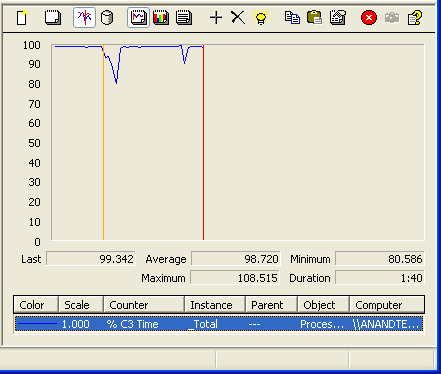
As you can probably guess, Perfmon is inaccurate in this case. While Perfmon does a fine job of monitoring C3 states for older processors, it fails to handle properly the CPUs we're most interested in: the Pentium M and Core Duo. Through our talented investigative journalism (read: by asking a question), we found that there is a tool to report accurately the amount of time spent in C3 on modern day Intel processors. Unfortunately, that tool is only available to OEMs, under NDA, for fine tuning their systems. Luckily, not everyone abides by the NDAs that their company signs, so we managed to get our hands on the tool.
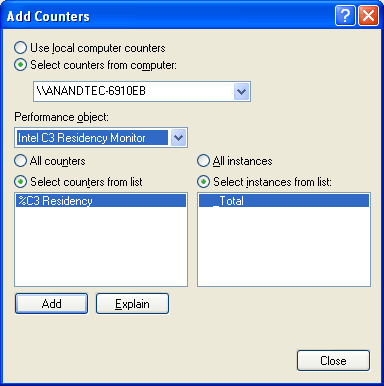
With the plugin installed, we now have another performance counter in Perfmon; this time, an accurate reflection of time spent in C3 or lower states. First up, we have Core Duo:
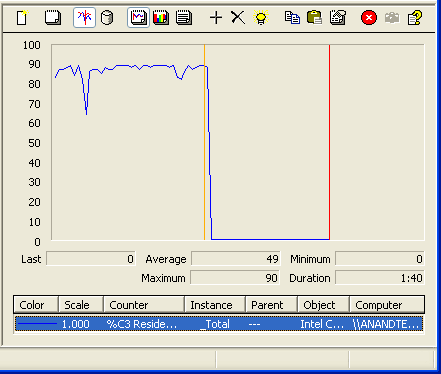
The orange vertical line indicates when we plugged in the USB 2.0 device
Next, we tried the same test with a USB 1.0 device, in this case a Microsoft Intellimouse Optical Blue mouse:

The orange vertical line indicates when we plugged in the USB 1.0 device
Now, the real question is whether or not the same problems exist on a previous generation Centrino system. In this case, we have the Lenovo T43 based on the Pentium M/Sonoma platform released approximately a year ago.
The first test was the same; plug in a USB 2.0 drive:
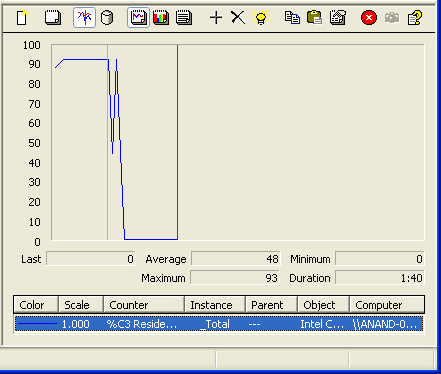
The orange vertical line indicates when we plugged in the USB 2.0 device
And just to be sure, we also did the USB 1.0/Mouse test:
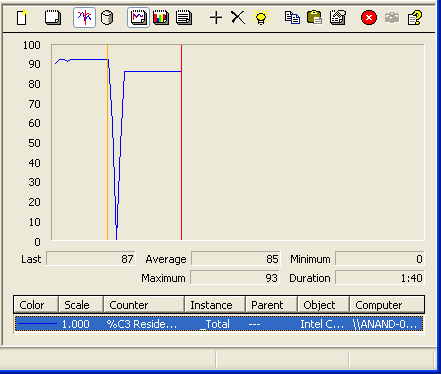
The orange vertical line indicates when we plugged in the USB 1.0 device










61 Comments
View All Comments
Eris23007 - Monday, February 13, 2006 - link
P.S. That's why you read more than just the intro and conclusion pages before asking questions."RTFM"
DigitalFreak - Monday, February 13, 2006 - link
Ha!Eris23007 - Monday, February 13, 2006 - link
The USB hard drive they tested with had its own power supply. The "USB Drive" was a flash device (USB bus powered), while the "External HDD" was:UNCjigga - Monday, February 13, 2006 - link
I will have to do some testing on my notebook with the 'workaround' fix installed. I could have sworn that around the time I installed SP2 on my lappy the battery life suffered, but this was about 6-12 months after I got it so I just figured the battery was getting old.Ionizer86 - Monday, February 13, 2006 - link
Wow, this is getting interesting. I'm surprised that this bug affects 915 based systems too. I wonder if this could be a broader issue that may affect intel 855 systems or AMD-based computers with chipsets from other vendors. I suppose I could do some playing aroundIonizer86 - Monday, February 13, 2006 - link
No edit button... (accidental post before completion).I could test this out on my 855 based laptop if only I had Perfmon and the special plugin :)
Ionizer86 - Tuesday, February 14, 2006 - link
Specs: Thinkpad R50e, Pentium M 1.5 on i855GME.I booted into Windows normal mode as cleanly as possible and ran Perfmon. The CPU was usually in C2 ~60% of the time and C3 ~35% of the time, for a total of ~95% in C2 or C3. Upon plugging in any of my USB stuff (an external hard disk, a Sandisk Cruzer mini, or even my IBM mouse), I'd get 95% in C2 and 0% in C3. Maybe my mouse is a USB 2.0 mouse; not sure.
Battery draw goes from about 11.7W to 12.5W when I plug in my mouse.
By adding the registry key, I no longer have the issue with the Cruzer or my external hard disk, but the problem with the mouse remains.
Looks like MSFT has quite a problem at hand.
Accord99 - Tuesday, February 14, 2006 - link
0.8W, maybe its the power draw of the mouse itself?johnsonx - Monday, February 13, 2006 - link
Adding to what Jason said, you only need the 'secret' plugin for Core Duo processors. The C3 state counter that Perfmon already has works fine on older platforms.IntelUser2000 - Tuesday, February 14, 2006 - link
Not just Core Duo, but: "As you can probably guess, Perfmon is inaccurate in this case. While Perfmon does a fine job of monitoring C3 states for older processors, it fails to handle properly the CPUs we're most interested in: the Pentium M and Core Duo."